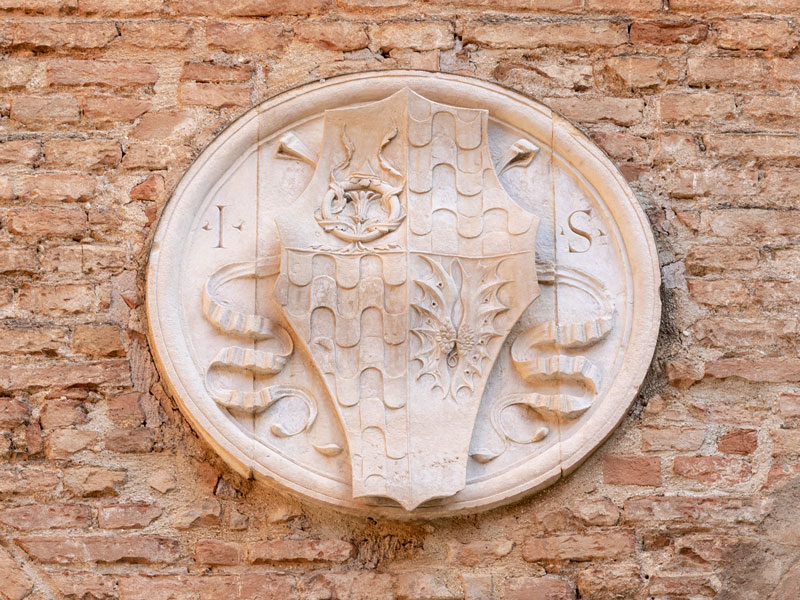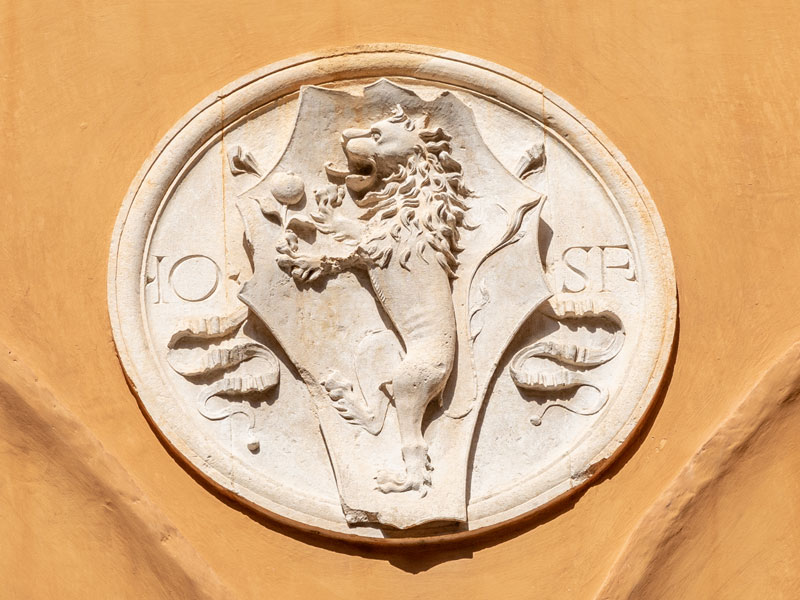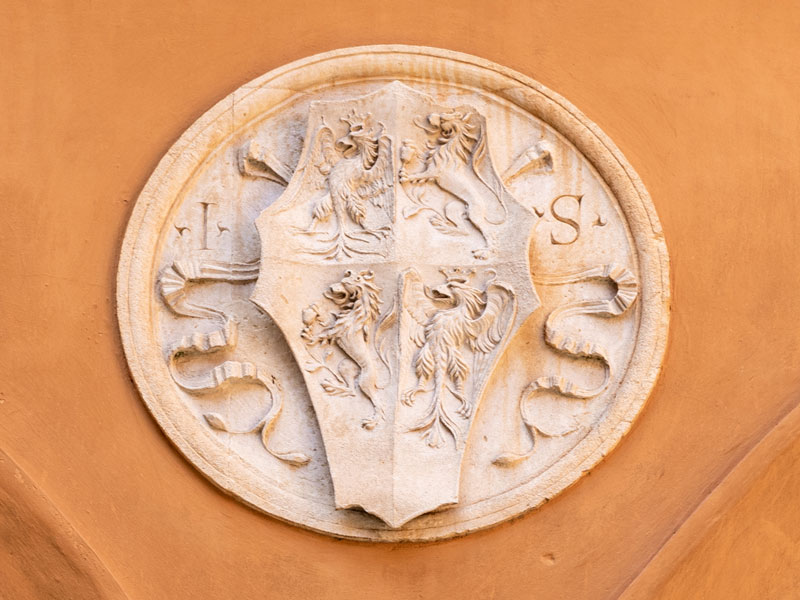Family
LA ROCCA
The Malatesti family
Between 1200 and 1300, the Rocca’s history is inextricably linked to the powerful Malatesti family, lords of Verucchio. In fact, a papal bull issued by Pope Boniface VIII awarded Gradara’s ownership to the family, expanding its power from Rimini towards the very desirable Marche territory.
Malatesti II da Verucchio (died in 1312), chief magistrate of Rimini, was a valiant Guelph warlord who was able to remove the Ghibelline families from the city, conquering numerous possessions. The eldest son, Malatestino, took the place of his father after his death, becoming lord of Rimini, while his brother Giovanni, called Gianciotto (“the cripple”), became famous for being the killer as well as betrayed husband of Francesca da Polenta, loved by his brother Paolo Malatesti.
If in the family there were many captains of arms recognised as brave warlords and as educated gentlemen, there was also a dark and bloody reputation. In fact, the Rocca was not only the place where the arts were celebrated, but also a place where nefarious intrigues took place, like the killing by Malatesti, known as the “Ruin of the family”, of his cousin Malatestino together with his son Guido and his father Ferrantino.
Sigismondo Pandolfo Malatesti (Brescia, 19 june 1417 – Rimini, 9 october 1468).
Sigismondo Pandolfo Malatesti is certainly the most prominent personality of the family thanks to his strong and eclectic personality, who was able to increase the family possessions, power and fame. Son of Pandolfo III and Antonia di Giacomino of Barignano, Sigismondo lost his father very early, at the age of 10, so power passed into the hands of Carlo, his uncle, who managed to obtain the legitimisation of the three sons of Pandolfo, governing on their behalf.
Sigismondo Pandolfo Malatesti grew in the refined court of his uncle, and in particular of his wife Elisabetta Gonzaga, a woman of great culture and elegance, from whom he learned the love of the arts and for the elect world of the courts.
He became lord of Rimini in 1432. During his government he had to oppose numerous reprisals by the lord of Pesaro, his brother Galeazzo Malatesti, and by Guidantonio di Montefeltro, Duke of Urbino. It was above all the latter’s successor, Federico da Montefeltro who became his enemy par excellence, because they were both men of culture, refined patrons and brave warlords.
Sigismondo was a man of great charm and extremely cultured. During his life he loved to surround himself with artists and writers, and they celebrated and exalted him in all his grandeur. He first married Ginevra D’Este, then Polissena Sforza and finally Isotta degli Atti, exceedingly beloved woman, to whom he dedicated the most famous works of art of the Malatesti Temple in Rimini.
During the Malatesti period, Rocca di Gradara was also the stage on which fierce battles unfolded. In 1446 Francesco Sforza besieged the castle for 40 days, but not being able to access it, he withdrew, unlike what happened in 1463, when Federico da Montefeltro managed to enter with his troops and the Rocca was given to the Sforza family.
After having participated in the battle against the Turks, during which Sigismondo Pandolfo Malatesti fell ill, the isolation and the decline of the family were now almost total, and, with the drying up of his personal prestige, Sigismondo died in 1468 in Rimini.
The Sforza family
Pesaro was ruled by the Sforza family from 1445 to 1512 with Alessandro, his son Costanzo and his nephew Giovanni, the latter being a key figure for Gradara because he lived in the Rocca for many years and carried out important architectural works.
In 1463 the Rocca was conquered by Federico da Montefeltro, who immediately gave the territory to Alessandro Sforza, lord of Pesaro since 1445, who in this way was consolidating the dominion of the family over the entire area of central Italy, on the border between Marche and Emilia Romagna.
Central Italy was practically entirely dominated by the family. Alessandro could count on the support of his brother Francesco Sforza, Duke of Milan, and on the support of Urbino, an alliance strengthened by the marriage between the educated and beautiful daughter Battista Sforza and Duke Federico da Montefeltro. The partnership between the courts of Milan, Urbino and Pesaro was not only a political union but also an intellectual and cultural one, leading to the circulation of works of art of inestimable value and of absolutely outstanding artists from the cultural scene of the time.
Giovanni Sforza, Count of Cotignola
Giovanni Sforza, son of Costanzo I and grandson of Alessandro Sforza, was lord of Pesaro from 1483 to 1512.
His is an unfortunate story, because to rule he bound himself to the Borgia family through Lucrezia, daughter of Pope Alexander VI and sister of Cesare Borgia, in a lavish marriage ceremony held in Rome on 12 June 1493.
The marriage between the two was short-lived. It was annulled after only four years in 1497 due to a change in the papal policy of Alexander VI, which aimed at a more politically advantageous marriage and a more valiant son-in-law.
Giovanni, a victim of a papal power play, was sent away from the city of Pesaro by Cesare Borgia Duke of Valentinois. He was able to return only once the pope died. Giovanni married once again in 1503, with Ginevra Tiepolo, who bore him a son, Costanzo, who died at an early age in 1512, year in which the control of Pesaro passed to the Della Rovere family.
Giovanni in Gradara gave a strong impulse of artistic and especially architectural innovation, as attested to by an inscription on the drawbridge of the Rocca, where, in addition to the patron’s name, is also mentioned the date of the works: 1494. These works were probably made to accommodate the new bride Lucrezia, in a house surrounded by the greenery of the Marche hills.
Lucrezia Borgia (Subiaco, 18 April 1480 – Ferrara, 24 June 1519).
Lucrezia Borgia, one of the most controversial and famous women in history, is tightly linked to the Rocca di Gradara by her marriage with Giovanni Sforza, lord of Pesaro.
Lucrezia is the third daughter of Cardinal Rodrigo Borgia and Vannozza Cattanei, an extremely beautiful woman.
Rodrigo Borgia, elected pope with the name of Alexander VI, used his children as pawns during his reign as pope in a political strategy to achieve the absolute prestige of the family. In these political plans Lucrezia and her brother Cesare Borgia, Duke of Valentinois, turned out to be particularly precious.
Lucrezia is described as a beautiful woman with long blond hair, graceful dancer, an expert in music, talented in singing and skilful in embroidery. She liked beautiful clothes and precious jewels, she was an educated reader of classics and literature, and she was celebrated in the works of important artists of the time such as Pietro Bembo and Ludovico Ariosto.
At age 11, her father drew up for Lucrezia her first wedding contract with the Valencian Cherubino Juan de Centelles, lord of Val d’Ayora, but the marriage was quickly annulled in favour of an engagement with the count of Procida in the Kingdom of Naples, Gaspare d’Aversa.
Once assumed the office of pope, in 1492, to thank Cardinal Ascanio Sforza who contributed in an important way to his election, he decided to have Lucrezia marry Giovanni Sforza, lord of Pesaro and count of Cotignola. In 1494, the changed political conditions led the pope to change alliances and the marriage was annulled.
Lucrezia died in Ferrara in 1519, not before she had contracted a new union with Alfonso d’Este, initially doubtful about the wedding because of the much gossip about the woman’s moral integrity. After three pregnancies ended badly, in 1508 Lucrezia gave birth to the heir of the d’Este family, Ercole, but he passed away at a young age, only 35 years old.
Family Histories
LA ROCCA
The Malatesti family
Between 1200 and 1300, the Rocca’s history is inextricably linked to the powerful Malatesti family, lords of Verucchio. In fact, a papal bull issued by Pope Boniface VIII awarded Gradara’s ownership to the family, expanding its power from Rimini towards the very desirable Marche territory.
Malatesti II da Verucchio (died in 1312), chief magistrate of Rimini, was a valiant Guelph warlord who was able to remove the Ghibelline families from the city, conquering numerous possessions. The eldest son, Malatestino, took the place of his father after his death, becoming lord of Rimini, while his brother Giovanni, called Gianciotto (“the cripple”), became famous for being the killer as well as betrayed husband of Francesca da Polenta, loved by his brother Paolo Malatesti.
If in the family there were many captains of arms recognised as brave warlords and as educated gentlemen, there was also a dark and bloody reputation. In fact, the Rocca was not only the place where the arts were celebrated, but also a place where nefarious intrigues took place, like the killing by Malatesti, known as the “Ruin of the family”, of his cousin Malatestino together with his son Guido and his father Ferrantino.
Sigismondo Pandolfo Malatesti (Brescia, 19 june 1417 – Rimini, 9 october 1468).
Sigismondo Pandolfo Malatesti is certainly the most prominent personality of the family thanks to his strong and eclectic personality, who was able to increase the family possessions, power and fame. Son of Pandolfo III and Antonia di Giacomino of Barignano, Sigismondo lost his father very early, at the age of 10, so power passed into the hands of Carlo, his uncle, who managed to obtain the legitimisation of the three sons of Pandolfo, governing on their behalf.
Sigismondo Pandolfo Malatesti grew in the refined court of his uncle, and in particular of his wife Elisabetta Gonzaga, a woman of great culture and elegance, from whom he learned the love of the arts and for the elect world of the courts.
He became lord of Rimini in 1432. During his government he had to oppose numerous reprisals by the lord of Pesaro, his brother Galeazzo Malatesti, and by Guidantonio di Montefeltro, Duke of Urbino. It was above all the latter’s successor, Federico da Montefeltro who became his enemy par excellence, because they were both men of culture, refined patrons and brave warlords.
Sigismondo was a man of great charm and extremely cultured. During his life he loved to surround himself with artists and writers, and they celebrated and exalted him in all his grandeur. He first married Ginevra D’Este, then Polissena Sforza and finally Isotta degli Atti, exceedingly beloved woman, to whom he dedicated the most famous works of art of the Malatesti Temple in Rimini.
During the Malatesti period, Rocca di Gradara was also the stage on which fierce battles unfolded. In 1446 Francesco Sforza besieged the castle for 40 days, but not being able to access it, he withdrew, unlike what happened in 1463, when Federico da Montefeltro managed to enter with his troops and the Rocca was given to the Sforza family.
After having participated in the battle against the Turks, during which Sigismondo Pandolfo Malatesti fell ill, the isolation and the decline of the family were now almost total, and, with the drying up of his personal prestige, Sigismondo died in 1468 in Rimini.
The Sforza family
Pesaro was ruled by the Sforza family from 1445 to 1512 with Alessandro, his son Costanzo and his nephew Giovanni, the latter being a key figure for Gradara because he lived in the Rocca for many years and carried out important architectural works.
In 1463 the Rocca was conquered by Federico da Montefeltro, who immediately gave the territory to Alessandro Sforza, lord of Pesaro since 1445, who in this way was consolidating the dominion of the family over the entire area of central Italy, on the border between Marche and Emilia Romagna.
Central Italy was practically entirely dominated by the family. Alessandro could count on the support of his brother Francesco Sforza, Duke of Milan, and on the support of Urbino, an alliance strengthened by the marriage between the educated and beautiful daughter Battista Sforza and Duke Federico da Montefeltro. The partnership between the courts of Milan, Urbino and Pesaro was not only a political union but also an intellectual and cultural one, leading to the circulation of works of art of inestimable value and of absolutely outstanding artists from the cultural scene of the time.
Giovanni Sforza, Count of Cotignola
Giovanni Sforza, son of Costanzo I and grandson of Alessandro Sforza, was lord of Pesaro from 1483 to 1512.
His is an unfortunate story, because to rule he bound himself to the Borgia family through Lucrezia, daughter of Pope Alexander VI and sister of Cesare Borgia, in a lavish marriage ceremony held in Rome on 12 June 1493.
The marriage between the two was short-lived. It was annulled after only four years in 1497 due to a change in the papal policy of Alexander VI, which aimed at a more politically advantageous marriage and a more valiant son-in-law.
Giovanni, a victim of a papal power play, was sent away from the city of Pesaro by Cesare Borgia Duke of Valentinois. He was able to return only once the pope died. Giovanni married once again in 1503, with Ginevra Tiepolo, who bore him a son, Costanzo, who died at an early age in 1512, year in which the control of Pesaro passed to the Della Rovere family.
Giovanni in Gradara gave a strong impulse of artistic and especially architectural innovation, as attested to by an inscription on the drawbridge of the Rocca, where, in addition to the patron’s name, is also mentioned the date of the works: 1494. These works were probably made to accommodate the new bride Lucrezia, in a house surrounded by the greenery of the Marche hills.
Lucrezia Borgia (Subiaco, 18 April 1480 – Ferrara, 24 June 1519).
Lucrezia Borgia, one of the most controversial and famous women in history, is tightly linked to the Rocca di Gradara by her marriage with Giovanni Sforza, lord of Pesaro.
Lucrezia is the third daughter of Cardinal Rodrigo Borgia and Vannozza Cattanei, an extremely beautiful woman.
Rodrigo Borgia, elected pope with the name of Alexander VI, used his children as pawns during his reign as pope in a political strategy to achieve the absolute prestige of the family. In these political plans Lucrezia and her brother Cesare Borgia, Duke of Valentinois, turned out to be particularly precious.
Lucrezia is described as a beautiful woman with long blond hair, graceful dancer, an expert in music, talented in singing and skilful in embroidery. She liked beautiful clothes and precious jewels, she was an educated reader of classics and literature, and she was celebrated in the works of important artists of the time such as Pietro Bembo and Ludovico Ariosto.
At age 11, her father drew up for Lucrezia her first wedding contract with the Valencian Cherubino Juan de Centelles, lord of Val d’Ayora, but the marriage was quickly annulled in favour of an engagement with the count of Procida in the Kingdom of Naples, Gaspare d’Aversa.
Once assumed the office of pope, in 1492, to thank Cardinal Ascanio Sforza who contributed in an important way to his election, he decided to have Lucrezia marry Giovanni Sforza, lord of Pesaro and count of Cotignola. In 1494, the changed political conditions led the pope to change alliances and the marriage was annulled.
Lucrezia died in Ferrara in 1519, not before she had contracted a new union with Alfonso d’Este, initially doubtful about the wedding because of the much gossip about the woman’s moral integrity. After three pregnancies ended badly, in 1508 Lucrezia gave birth to the heir of the d’Este family, Ercole, but he passed away at a young age, only 35 years old.



SCHEDULE
The Rocca di Gradara is temporarily closed to the public
ADDRESS
Piazza Alberta Porta Natale, 1
61012 Gradara (PU)
EDUCATION
Book free experiences

